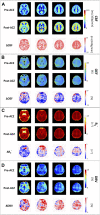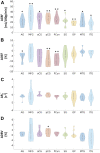Cortical oxygen extraction fraction using quantitative BOLD MRI and cerebral blood flow during vasodilation
- PMID: 37869717
- PMCID: PMC10588655
- DOI: 10.3389/fphys.2023.1231793
Cortical oxygen extraction fraction using quantitative BOLD MRI and cerebral blood flow during vasodilation
Abstract
Introduction: We aimed to demonstrate non-invasive measurements of regional oxygen extraction fraction (OEF) from quantitative BOLD MRI modeling at baseline and after pharmacological vasodilation. We hypothesized that OEF decreases in response to vasodilation with acetazolamide (ACZ) in healthy conditions, reflecting compensation in regions with increased cerebral blood flow (CBF), while cerebral metabolic rate of oxygen (CMRO2) remained unchanged. We also aimed to assess the relationship between OEF and perfusion in the default mode network (DMN) regions that have shown associations with vascular risk factors and cerebrovascular reactivity in different neurological conditions. Material and methods: Eight healthy subjects (47 ± 13 years, 6 female) were scanned on a 3 T scanner with a 32-channel head coil before and after administration of 15 mg/kg ACZ as a pharmacological vasodilator. The MR imaging acquisition protocols included: 1) A Gradient Echo Slice Excitation Profile Imaging Asymmetric Spin Echo scan to quantify OEF, deoxygenated blood volume, and reversible transverse relaxation rate (R2 ') and 2) a multi-post labeling delay arterial spin labeling scan to measure CBF. To assess changes in each parameter due to vasodilation, two-way t-tests were performed for all pairs (baseline versus vasodilation) in the DMN brain regions with Bonferroni correction for multiple comparisons. The relationships between CBF versus OEF and CBF versus R2' were analyzed and compared across DMN regions using linear, mixed-effect models. Results: During vasodilation, CBF significantly increased in the medial frontal cortex (), posterior cingulate gyrus (pCG) (), precuneus cortex (PCun) (), and occipital pole (). Concurrently, a significant decrease in OEF was observed only in the pCG (8.8%, ) and PCun (). CMRO2 showed a trend of increased values after vasodilation, but these differences were not significant after correction for multiple comparisons Although R2' showed a slightly decreasing trend, no statistically significant changes were found in any regions in response to ACZ. The CBF response to ACZ exhibited a stronger negative correlation with OEF (; ), than with R2' (; ). Conclusion: Quantitative BOLD modeling can reliably measure OEF across multiple physiological conditions and captures vascular changes with higher sensitivity than R2' values. The inverse correlation between OEF and CBF across regions in DMN, suggests that these two measurements, in response to ACZ vasodilation, are reliable indicators of tissue health in this healthy cohort.
Keywords: Oxygen extraction fraction (OEF); arterial spin labeling (ASL) MRI; cerebral blood flow (CBF); magnetic resonance imaging (MRI); quantitative BOLD (qBOLD); vasodilation.
Copyright © 2023 Le, Wheeler, Holy, Donnay, Blockley, Yee, Ng and Fan.
Conflict of interest statement
The authors declare that the research was conducted in the absence of any commercial or financial relationships that could be construed as a potential conflict of interest.
Figures




References
-
- Alsop D. C., Detre J. A., Golay X., Günther M., Hendrikse J., Hernandez-Garcia L., et al. (2015). Recommended implementation of arterial spin-labeled perfusion MRI for clinical applications: A consensus of the ismrm perfusion study group and the European consortium for ASL in dementia. Magn. Reson. Med. 73, 102–116. 10.1002/mrm.25197 - DOI - PMC - PubMed
-
- Andersson J. L. R., Jenkinson M., Smith S. (2010). Non-linear registration, aka spatial normalisation FMRIB technical report TR07JA2.

